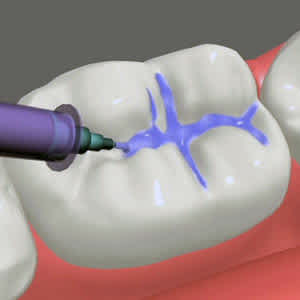What can we do to prevent tooth decay ?


Dental caries, also known as tooth decay, is a common dental problem that affects young and old people. While maintaining good oral hygiene through regular brushing and flossing is important in preventing tooth decay, sometimes it may not be enough. That's where dental sealants play a good role.
Dental sealants are thin, protective coatings that are applied to the chewing surfaces of teeth to prevent cavities. These coatings are usually made of resin and are painted onto the pits and fissures of teeth, particularly molars, and premolars, which are more prone to decay due to their rough, uneven surfaces that can trap food and bacteria.
Here's everything you need to know about pit and fissure sealants.
How do pit and fissure sealants work?
The chewing surfaces of teeth are made up of ridges and grooves called pits and fissures, which can be difficult to clean with a toothbrush. Bacteria and food particles can get trapped in these grooves, leading to the formation of cavities. Sealants are a barrier, preventing food and bacteria from getting into these grooves and protecting the teeth from decay.
Sealants are particularly effective in preventing cavities in children and teenagers. According to the American Dental Association, sealants can reduce the risk of tooth decay in molars by up to 80%. However, adults can also benefit from sealants, especially if they have deep pits and fissures on their molars.
What is the procedure for getting pit and fissure sealants?
Getting sealants is a quick, painless, and non-invasive procedure. Here are the steps involved:
Cleaning: The teeth are cleaned to remove any food particles or debris.
Etching: A special solution is applied to the teeth to roughen the surface and create a stronger bond between the sealant and the tooth.
Sealant application: The sealant is applied to the pits and fissures of the tooth, where it bonds and hardens into a protective coating.
Curing: A special light is used to cure or harden the sealant.
Once the sealant is applied, it can last for up to 10 years, with regular checkups and touch-ups if necessary.
Are there any risks or side effects associated with sealants?
Sealants are safe and do not cause any significant side effects. However, some people may experience minor sensitivity or discomfort after the procedure, which usually subsides within a few days. In rare cases, sealants may come off or wear away, exposing the tooth to decay.
It's important to note that sealants are not a substitute for good oral hygiene practices. Brushing and flossing regularly, along with a healthy diet and regular dental checkups, are still essential in maintaining good oral health.
In conclusion, pit and fissure sealants are a safe, effective, and non-invasive way to protect teeth from decay. They are particularly beneficial for children and teenagers, but adults can also benefit. If you're concerned about cavities or have deep pits and fissures on your teeth, talk to your dentist about whether sealants are a good option.

